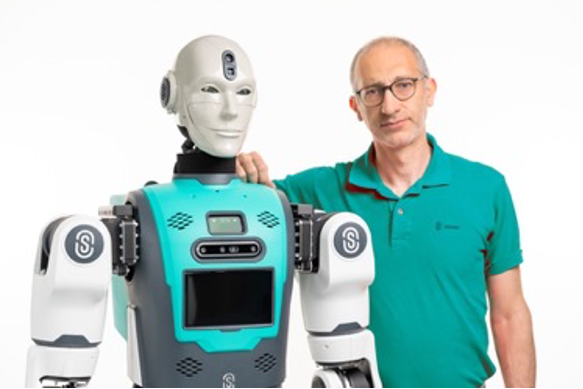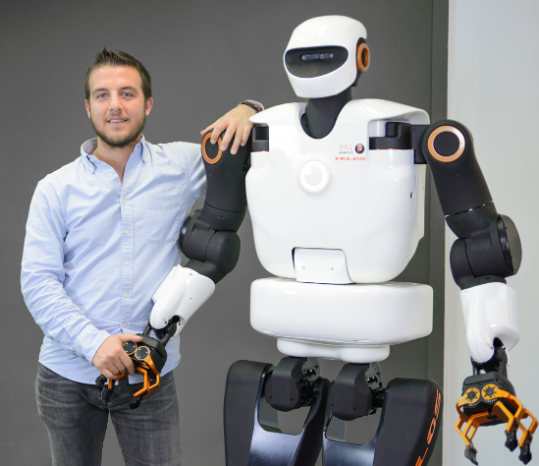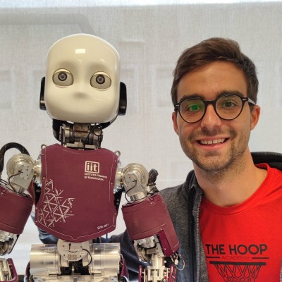WORKSHOP ON HUMANOID ROBOTICS GO UBIQUITOUS! INDUSTRIES AND RESEARCHERS AS THE KEY ENABLERS
19 September 2024 – 8:50 – 13:00
Human-like robots are set to be ubiquitous as mobility means, TV, home appliances, and smartphones. The impact is expected to be on every one of us in everyday life: we will interact to them in many ways, asking for help on a broad range of daily task we need to accomplish anytime.
Many industries, research entities and universities across the world are actively working on that and the list of them is growing with daily announcements of ground-breaking progress both from a technology standpoint and use cases. Indeed, initial deployments are in the logistic and manufacturing industry sectors where to gather experience, proof to be accurate and tune their functionalities; it is expected many others will be addressed in the very next years.
It’s an inevitable and revolutionary progress for humanity and from many points of view: research is suggesting increasing similarities to how human beings perceive, behave and act. This is inspiring and has motivated huge investments by many industries and start-ups in US, Europe, China and Japan. An example of progress is the need to provide ground-breaking decentralized AI algorithms, and many other sub-components with associated functional applications to build a sophisticated, complex, cooperative, and safe system such as a humanoid robot. Their electronics systems are required to be low energy and efficient, be accurate in their actions, adopt cheap sensors (any type of), and embody powerful next generation of embedded processing and actuators. All of that represents an unprecedented unique opportunity for AI to evolve to the next level for the entire humanity to benefit from.
This workshop is aimed to present some examples of humanoid robots developed in Italy and Europe both at industrial and research level. Many involved dimensions will be represented such as applications, AI algorithms, mechanical components, and electronics.
Furthermore, the workshop will help to reason on the impacts Humanoid Robotics can bring to the broader industry and humanity. They will be the main actors of making happen and widely available to the scale what Alain Turing imagined on mid-20th century.
Two major topics will be addressed during the Workshop: (i) some exemplary applications that shows the practicality of the approaches and the benefits introduced; and (ii) the perspective from representative experts of the electronic industry who are called to provide essential components to let humanoid robots to scale.
The workshop is structured with individual presentations and a round table where all the invited speakers will be involved in an interactive debate managed by a moderator.
08:50 – Welcome to participants
Danilo Pau (ST) and Tiziana Tambosso (R8 CoCC Chair)
09:00 – Humanoid Robots: Challenges and Perspective in Automation
Fabio Ruggiero (Italy Section RAS Chapter Chair)
09:15 – A predictive approach for Maintenance and Safety of a wheeled humanoid robot
Fabio Puglia (CEO – Oversonic Robotics)
09:30 – Humanoid robots that learn: challenges and applications
Lorenzo Natale (Italian Institute of Technology)
09:45 – Advancements in high performance humanoid robot functionalities
Luca Marchionni (CTO – PAL Robotics)
10:00 – What Does a Robot Need to Be Human? The Journey of Abel
Lorenzo Cominelli (University of Pisa)
10:15 – Thrustable autonomy for efficient and safe deliberation
Marco Roveri (University of Trento)
10:30 – 11:00 – COFFEE BREAK
11:00 – Enhancing Humanoid Robot Autonomy: An ISPU-Based Approach to Fall Detection and Prevention
Giuseppe Messina (System Research – STMicroelectronics)
11:15 – High density power controllers for Robotics
Giulio Ricotti (Design Director – STMicroelectronics)
11:30 – Industrial IMUs to monitor robotic applications
Marco Bianco (MEMS Software Solutions Manager – STMicroelectronics)
11:45 – Langbotics – Let Robotic Agents Reason About the World
Simone Voto (Reply Concept)
12:00 – Exploring the Role of 6G Technology in Robotics Applications
Mona Ghassemian (Huawei)
12:15 – 12:30 – Q&A & Round Table
Moderators: Danilo Pau, Fabio Ruggiero

Fabio Ruggiero
Humanoid Robots: Challenges and Perspective in Automation
ABSTRACT
This talk will explore the possible exploitation of humanoids and quadruped robots in recent application domains (i.e., agriculture, manufacturing, etc.). The challenges and perspective in the automation domain will be briefly analyzed with reference to model-based approaches and recent massive deep reinforcement learning solutions. Finally, some mechatronic development carried out at PRISMA Lab for constructing a small-legged robot will be presented.
SHORT BIOGRAPHY
Fabio Ruggiero is Associate Professor of Automatic Control and Robotics in the Department of Electrical Engineering and Information Technology at University of Naples Federico II, where he is responsible for the DynLeg (Dynamic manipulation and Legged robotics) research area. He is Chair of the IEEE Italy RAS Chapter. He is Associate Editor of IEEE Transaction on Robotics, and he has been Program Committee member of some international conferences. He has published more than 100 journal articles, conference papers, and book chapters. He has participated to several European research projects, with the role of WP leader. He has been principal investigator of four projects funded by the Italian Ministry of Research.

Fabio Puglia
A predictive approach for Maintenance and Safety of a wheeled humanoid robot
ABSTRACT
Managing RoBee, a cognitive wheeled humanoid robot, relies heavily on analyzing real-time data from telemetry services. This supports Predictive Behavior and Predictive Maintenance algorithms, such as managing the machine’s center of mass (ZMP), optimizing acceleration curves and joint jerks, and interacting physically with the environment. To make this feasible, compliance with machinery and software safety rules is crucial. This overview presents the strategies ensuring algorithmic decisions, especially real-time ones, align with safety regulations (V-Model, Machinery Directive), even when utilizing neural networks and predictive models.
SHORT BIOGRAPHY
Fabio Puglia, a graduate in Physics and Mathematics from the University of Milan, specializes in robotics and automation. His career spans both robotics and space physics. After a managerial career that took him to work in Abu Dhabi, Tel Aviv, and Pittsburgh, extending his activities to the Water and Energy sector, he founded his first tech start-up in 2014. In 2017, he was invited to present his technological solution at ICT Pasadena by JPL_NASA. Subsequently, he developed calorimetry systems for major European particle accelerators, including INFN. In 2018, he was among the founders of the Cyber Security Hub Start 4.0 of MiSE in Genoa. Since 2020, he has co-founded Oversonic Robotics with Paolo Denti, where he serves as President and CTO. Oversonic Robotics is the company behind RoBee, the first cognitive humanoid robot made in Italy, designed for operations in factories and healthcare facilities. In 2023, he was invited by MIMIT to participate in the Italy-France-Germany trilateral meeting on guidelines for the AI Act. He has established technological partnerships with leading universities and research centers worldwide, making Oversonic Robotics one of the most significant technological platforms in Europe.

Lorenzo Natale
Humanoid robots that learn: challenges and applications
ABSTRACT
Modern AI algorithms provide exceptional performance, but require long training time and large, annotated, datasets. This hampers their application in those settings, such as robotics, in which data is scarce. In this talk I will provide and overview of our work, in which we develop learning algorithms that allow robots to learn from the interaction with the environment. I will then present applications of humanoids in the domains of human-robot collaboration and service robotics.
SHORT BIOGRAPHY
Lorenzo Natale is Tenured Senior Researcher at the Italian Institute of Technology and Coordinator of the Center for Robotics and Intelligent Systems. He received MS and PhD in Robotics from the University of Genoa and was later on postdoctoral researcher at the MIT Computer Science and Artificial Intelligence Laboratory. Lorenzo Natale has been involved in the development of several robots and was one of the main contributors to the design and development of the iCub platform and its software architecture. His research interests range from vision and tactile sensing to software architectures for robotics. He is Ellis Fellow and Core Faculty of the Ellis Genoa Unit.

Luca Marchionni
Advancements in high performance humanoid robot functionalities
ABSTRACT
High-performance bipeds and their interactions with humans will be presented, including how their hardware and software help facilitate this. This talk will also detail the latest work at PAL Robotics including the newest platforms created and in development – TIAGo Pro and Kangaroo – and the physical and social interactions we are working towards that are the key to successfully integrating robots into human environments.
SHORT BIOGRAPHY
Luca Marchionni is the Chief Technology Officer (CTO) of PAL Robotics, a leading robotics company based in Barcelona, Spain. With a strong background in robotics and control system engineering, Marchionni has been instrumental in driving the development of advanced humanoid robots at PAL Robotics. He obtained his BSc in Control Engineering in 2005 and his MSc in Systems and Control Engineering in 2007, both from the University of Rome La Sapienza, which provided him with a deep understanding of the field, allowing him to lead innovative projects that push the boundaries of robotics technology. Under his leadership, PAL Robotics has made significant strides in various sectors, including healthcare, logistics, and retail, by deploying robots that enhance human capabilities and improve operational efficiency. Marchionni is recognized for his strategic vision and technical expertise, which have been critical in positioning PAL Robotics as a global leader in the robotics industry. His work focuses on integrating cutting-edge technologies like machine learning, computer vision, and autonomous systems into the company’s product offerings, ensuring that PAL Robotics remains at the forefront of technological advancements.

Lorenzo Cominelli
What Does a Robot Need to Be Human? The Journey of Abel
ABSTRACT
In the quest to bridge the gap between humans and machines, “What Does a Robot Need to Be Human? The Journey of Abel” explores the intricate process of designing Abel, a highly realistic humanoid social robot. This presentation examines the meticulous design choices, the development phases, and the underlying motivations that shaped Abel’s creation. We will discuss the innovative systems integrated into Abel to foster emotional interactions and the potential societal impacts of such advancements. Additionally, the presentation will address the ethical considerations and strategies to mitigate risks associated with emotional interactions between humans and robots. Join us to uncover what it truly means for a robot to be human.
SHORT BIOGRAPHY
Lorenzo Cominelli holds a Master’s Degree in Biomedical Engineering (2014) and a Ph.D. in Automation, Robotics, and Biomedical Engineering (2018) from the University of Pisa. Currently serving as a Technologist at the Information Engineering Department (DII), he collaborates closely with the renowned “E. Piaggio” Research Center. His research in AI and Cognitive Systems focuses on integrating emotions into robots’ decision-making processes. Since 2021, Lorenzo has been at the forefront of developing Abel, a hyper-realistic humanoid robot designed to express a wide range of emotions and create an empathetic bond with human interlocutors. Beyond his research, Lorenzo is dedicated to education and outreach, teaching social robotics across various engineering courses, and presenting at numerous international conferences and symposia. He also works extensively with computer engineers from the Information Engineering Department to create sophisticated cognitive systems that blend knowledge-based and data-driven approaches. This innovative work aims to develop versatile agents capable of adapting to social contexts while ensuring they remain controllable and explainable.

Marco Roveri
Thrustable autonomy for efficient and safe deliberation
ABSTRACT
The increase in task complexity and the interaction in different environments and with humans requires robots, and in particular humanoids, to exhibit a higher level of autonomy for efficient deliberation, and automated task and motion planning is a key element of deliberation, which starts to enter the robotic domain to complement other data-driven approaches. We will overview existing approaches, challenges and a possible architecture, with some preliminary application to the ARI robotic system.
SHORT BIOGRAPHY
Marco Roveri received a Ph.D. degree in Computer Science from the University of Milano, Italy in 2002. He is an Associate Professor in the Information Engineering and Computer Science Department of the University of Trento, Italy. He was a Senior Researcher in the Embedded Systems Unit of Fondazione Bruno Kessler in Trento, and before a researcher in the Automated Reasoning Division of the Istituto Trentino di Cultura also in Trento. His research interests include automated model-based planning, formal requirements verification and validation, formal verification of hardware and software systems, formal cyber security, model-based predictive maintenance, and application of such techniques in industrial settings. He recently is working on applications of automated model-based task and motion planning.

Giuseppe Messina
Enhancing Humanoid Robot Autonomy: An ISPU-Based Approach to Fall Detection and Prevention
ABSTRACT
This research presents a fall detection and prevention through the integration of an Intelligent Sensor Processing Unit (ISPU) into a humanoid robot. The core of the methodology lies in the implementation of a neural network within the ISPU, which is trained to discriminate between various fall scenarios. By processing sensor data in real-time, the neural network can recognize the onset and direction of a fall with high accuracy. Upon detection of a fall, the system swiftly calculates the optimal response to mitigate the impact, thereby reducing the risk of damage to the robot. The ISPU’s real-time capabilities allow for rapid decision-making, enabling the humanoid robot to execute preventive measures such as adjusting its posture or performing a controlled descent. The results demonstrate the effectiveness of the ISPU and neural network combination in enhancing the robot’s autonomous response to fall incidents.
SHORT BIOGRAPHY
Giuseppe Messina received his MS degree in Computer Science in 2000 at the University of Catania doing a thesis about Statistical Methods for Textures Discrimination. He received his Ph.D. in 2011 in Computer Science at the University of Catania accomplishing research in Advanced Techniques for Image Analysis and Enhancement. Since March 2001, he has been working at STMicroelectronics in the System Research and Application group, Artificial Intelligence and Tools team as Member of Technical Staff. He has also been a member of the Image Processing Laboratory, at the University of Catania. His research interests are in the field of Image Analysis, Image Quality Enhancement, Forensic Imaging and Robotics. His last works were on Embedded Software for drone flight control units and robotics. He is an author of several papers and patents, and reviewer for several international journals and conferences. He has been nominated IEEE Senior Member in 2017.

Giulio Ricotti
High density power controllers for Robotics
ABSTRACT
How the evolution of Smart Power BCD technology contributed to the fast development of energy management and the motor driver for robotics. A particular focus on the capability of this technology to integrate fine analog functions with power transistors and huge digital controllers and non-volatile memory, it’s a perfect mix of ingredients for robotics enabling high density power controllers.
SHORT BIOGRAPHY
Giulio Ricotti after earning his Electronics Engineering degree, joined ST in 1994 as a design engineer in their Smart Power (SP) products group. Currently is Design Director and Company Fellow, he has more than 60 patents and has authored 70 publications. Giulio has also been awarded the “Premio dei Premi” in 2009 by the Italian president Giorgio Napolitano for his crucial contribution to innovation with the 4D ultrasound imaging project that is used today all over the world for pregnancy and cardiology screenings.

Marco Bianco
Industrial IMUs to monitor robotic applications
ABSTRACT
Smart factories are moving to Industry 5.0 style of production, using more and more robots and smaller cobots to customize end products.
Robots move and rotate constantly, and any malfunction will cause line down in production.
In this speech we will highlight the latest improvements on industrial IMUs (Inertial Measurement Units) and how they can be used in robot or cobot applications.
SHORT BIOGRAPHY
MEMS Software Solutions Manager – STMicroelectronics.
Leading the development of software tools and innovative algorithms for motion and environmental MEMS sensors, Marco focuses on in-sensor computing. In addition to supporting STMicroelectronics key customers and providing engineers with insightful solutions for their applications, he has filed several patents covering the industrial, automotive, and personal electronics markets.

Simone Voto
Langbotics – Let Robotic Agents Reason About the World
ABSTRACT
LANGBOTICS introduces a novel approach to mission decoding for robotic agents, offering a methodical process comprising five sequential steps: identification, safety evaluation, feasibility assessment, mission decomposition, and low-level decoding. Unlike existing solutions, LANGBOTICS prioritizes adaptability, catering to a wide range of robotic platforms. Its notable feature is the incorporation of built-in AI explainability (XAI), which enhances transparency in decision-making and facilitates smoother human-robot interaction. This session aims to showcase a pragmatic solution that addresses current market needs while laying the groundwork for further advancements in robotics and collaborative human-machine interactions.
SHORT BIOGRAPHY
Simone Voto is a robotics engineer with over two years of experience in defining and implementing solutions with various robots. Currently, he is the Robotics Tech Lead at Concept Engineering, where he oversees all projects related to robotics. Additionally, he leads the Research and Development department within the company, focusing on defining and realizing innovative projects using robots.

Mona Gassemian
Exploring the Role of 6G Technology in Robotics Applications
ABSTRACT
The development of 6G technology holds immense potential for the world of robotics applications, presenting exciting opportunities and capabilities that can transform advanced autonomous systems communication. This talk will explore the synergistic relationship between 6G and the potential advancements in robotics applications including droids and humanoid robotics. The focus will be on the remarkable benefits that 6G-enabling technologies and capabilities can bring to the table, including Integrated Sensing and Communication (ISAC), Hyper-Reliable Low-Latency Connectivity, and Ubiquitous Connectivity. These 6G-enabling technologies can equip robots with advanced sensory capabilities that surpass human limitations, as well as enhancing their communication and perception abilities.
SHORT BIOGRAPHY
Mona Ghassemian has over 20 years of experience in wireless and telecommunications research and Development (R&D). She holds a PhD from King’s College London and currently works as a 6G principal expert for Huawei, leading strategic R&D. Mona previously held senior roles at InterDigital and British Telecom, and has an extensive publication record, including 70+ papers and 13 patents. She is active in industry standards bodies (3GPP, ITU-R, IEEE, ETSI, and IETF).
Mona is a member of the IEEE P1918.1 Tactile Internet Working Group, the IEEE UK & Ireland Section Nominations and Elections Chair, and the IEEE Region 8 Standards Coordination Chair.

